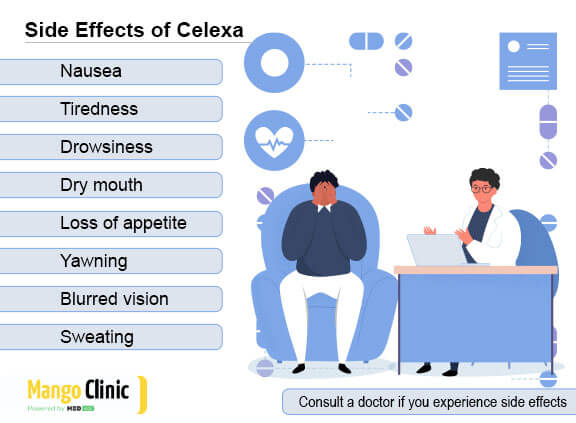How Long Does It Take for Celexa to Work

Having chronic anxiety is debilitating. The constant state of worry and fear can affect a person’s quality of life and prevent them from functioning normally. Today, healthcare providers choose treatment options with proven effectiveness: antianxiety and antidepressant drugs and psychotherapy. One such drug option for anxiety is Celexa.
Celexa can alter brain chemistry to reduce anxiety symptoms and improve mood. In this post, let’s learn more about it and how fast it can achieve the desired result. We will start with a brief overview of this medicine.
Ask a licensed doctor if you need pharmacological treatment for anxiety and get a prescription online.
What is Citalopram (Celexa)
Celexa, the brand name for Citalopram, is an FDA-approved antidepressant. It is commonly prescribed for major depressive disorder but can also be prescribed off-label to treat anxiety disorders, including social anxiety disorder, generalized anxiety disorder, and panic disorder.
“Off-label” is when a doctor prescribes a medication for indications not approved by the FDA. The doctor prescribes the drug if they believe it suits a person’s circumstances.
How Does Celexa Work?
Celexa is a selective serotonin reuptake inhibitor (SSRI). This is a type of medication that works by boosting serotonin levels in the brain, which can improve a person’s energy levels and well-being. Serotonin is a neurotransmitter that sends signals between nerve cells in the brain and throughout the body. It is important for regulating mood, behavior, thoughts, memory, digestion, and metabolism.
In normal functioning, serotonin is released into the space between two nerve cells to initiate a signal and nerve impulse. Once it has carried a message, serotonin enters a “reuptake” pump, where it is recycled by the brain. This process balances the amount of serotonin in the brain. In people with anxiety, it’s believed that too much reuptake happens, leading to insufficient amounts of this neurotransmitter.

SSRIs like Celexa block the reuptake process, making more serotonin available to improve the transmission of messages between nerve cells. Having more serotonin present in the brain results in a better mood and anxiety regulation. SSRIs are selective for serotonin, which means that they don’t affect the uptake of other neurotransmitters in the brain.
How Quickly Does Celexa Start Working?
The time it takes for Celexa to work depends on a person’s experience with anxiety and how they react to medications. Typically, the drug reaches its peak concentration in the blood within four hours of the first dose. However, it’s worth noting that the positive effects of citalopram won’t be experienced immediately. It takes time for serotonin levels to build up and become balanced in the brain to help reduce anxiety and regulate mood.
When a person takes Celexa for anxiety, it generally takes 4-6 weeks for the drug to reach its full potential. Within the first 1-2 weeks, however, a person may notice small improvements in their daily life, including improved sleep, better appetite, and higher energy levels. These changes are the first indicators that the drug is working.
While there’s no straight answer to the question, “how long does Citalopram take to work?” 1 to 6 weeks is a good reference point. If a person doesn’t see any improvements after about 6 to 8 weeks, they should talk to their doctor about adjusting the citalopram dosage or switching to another treatment. An individual shouldn’t quit Celexa without a doctor’s advice.
Consult a doctor if you don’t notice any improvement in 4-6 weeks to adjust your treatment plan or choose another medication.
Side Effects of Celexa
SSRIs are generally considered safe and cause fewer side effects than other types of antidepressants. But as is the case with any other medication, Celexa can cause several side effects. Many will manifest in the first week of treatment and diminish as the body gets used to the medication.
Common Celexa side effects include:
- Nausea
- Sleeping difficulties (can be insomnia or drowsiness)
- Dry mouth, thirst
- Increased urination or sweating
- Loss of appetite
- Constipation
- Diarrhea
- Weakness
- Feeling anxious or agitated
- Increased muscle movement
- Cold symptoms such as sneezing, stuffy nose, sore throat
- Reduced sexual desire
Celexa Withdrawal Timeline
When Celexa is taken for an extended period, the brain will become used to it, so if a person stops the medication, they might experience withdrawal symptoms. The body and brain will need to adjust to the new levels.
Celexa has a relatively short half-life of about 35 hours. The “half-life” of a drug is the time it takes for the concentration of the drug’s active substance in the body to reduce by half. In most patients taking Celexa, it takes 35 hours for half of the drug to be cleared from the body after the initial consumption. The half-life could extend between 45 to 50 hours for individuals 60+ years of age. Celexa may last as much as double the time in individuals with reduced liver function.

On average, it can take 10 to 14 days for Celexa to leave the body completely after the last dose. How quickly the drug leaves the body can be affected by the dosage one takes and an individual’s age, weight, sex, lifestyle, underlying medical conditions, and other factors. As is the case with many other medications, the body can retain remnants of the drug in urine, saliva, and hair follicles long after it has been filtered out of the bloodstream.
As Celexa reduces in the system, the brain has to adjust to lower serotonin levels. A person may begin to feel the onset of withdrawal symptoms. Although everyone will have a different withdrawal experience, symptoms typically follow a certain timeline. This can take anywhere from a few days to a few weeks, but it’s usually around the time citalopram completely leaves the body. Here’s an approximate timeline for Celexa’s withdrawal:
- Days 1-3: Mild withdrawal symptoms may begin to appear.
- Days 4-8: Symptoms may become more severe and may include nausea, fever, shakiness, dizziness, flu-like symptoms, mood swings, shock-like sensations, and headaches.
- Weeks 2-6: Withdrawal symptoms may persist for several weeks before gradually fading away.
Going off antidepressants should be under the guidance and supervision of a doctor. They can monitor progress as Celexa leaves the system and advise on the best course of action to decrease the chances of having severe withdrawal symptoms.
Bottom Line
The key to effective anxiety treatment is a good balance between vigilance and patience. A person will need to give Celexa time to work while taking an active role in their own mental health. Contact Mango Clinic today to get an individual plan and support during your anxiety treatment process.









